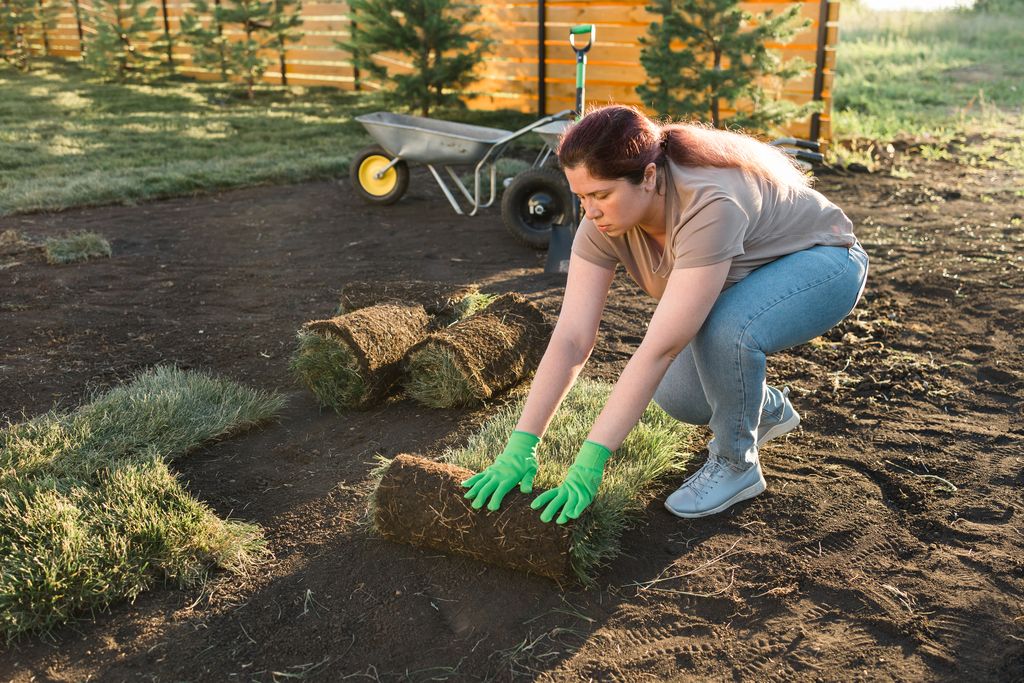Is your lawn looking patchy, weedy, or just plain tired? Before you rip everything out and start over, take a step back. Sometimes, a few simple fixes—like better watering, mowing, or fertilizing—can bring your grass back to life without a full renovation.
But if your lawn is beyond saving, don’t worry! Redoing your lawn the right way can give you a lush, green yard that’s easier to maintain. Here’s how to do it step by step.
This post contains affiliate links. As an Amazon Associate, I earn from qualifying purchases at no additional cost to you.
When Should You Redo Your Lawn?
Not every struggling lawn needs a full overhaul. Consider renovating if:
- 30-50% of your lawn is dead or thin—This could be from drought, pests, disease, or poor soil.
- The ground feels spongy—This usually means too much thatch (more than ¾ inch thick).
- Weeds have taken over—If weeds cover 30-50% of your lawn, it might be easier to start fresh.
- You want a lower-maintenance grass type—Overseeding with hardier varieties can save you time and effort.
The Best Time to Renovate Your Lawn
The ideal time is mid-August to mid-September when the weather is cooler but the soil is still warm. If you miss that window, early spring is your next best option.
Step-by-Step Lawn Renovation Guide
1. Test Your Soil
Before you do anything, get a soil test. Your local county extension office can help with this. The test will tell you what nutrients your soil lacks so you can fertilize properly.
2. Kill the Weeds
If weeds are your main problem:
- Use a broadleaf herbicide for weeds like dandelions.
- For a full reset, a non-selective herbicide (like glyphosate) will kill everything—but you’ll need to wait 5-14 days before moving forward.
(Always follow the label instructions on any herbicide!)
3. Water the Soil
Moisten the soil 6-8 inches deep, then let the surface dry for a day or two before moving on.
4. Mow Short
Cut your existing grass down to 1 inch tall. This helps sunlight reach new seeds and encourages faster growth.
5. Remove Thatch
If your lawn feels spongy, it’s likely full of thatch (dead grass buildup).
- For small areas: Rake vigorously.
- For big lawns: Rent a vertical mower or hire a pro to remove thick thatch.
- Extreme cases: Use a sod cutter to strip everything away.
6. Loosen the Soil
- For compacted soil: Use an aerator (3-5 passes).
- For seedbed prep: A vertical mower can scratch the soil surface to help seeds take root.
7. Fertilize Smart
Use a balanced fertilizer (N-P-K) based on your soil test.
- Avoid too much nitrogen—it makes existing grass grow too fast and choke out new seedlings.
- After seeding, use a slow-release nitrogen fertilizer (½ pound per 1,000 sq ft).
8. Seed the Right Way
- Choose the best grass mix for your lawn (see recommendations below).
- Split your seed in half and spread it in two directions for even coverage.
- For small patches: Mix seed with fertilizer (1:4 ratio) for easier spreading.
- For large areas: Use a drop or rotary spreader.
- Slit seeders (rent or hire a pro) plant seeds directly into the soil for better results.
9. Water Gently but Often
- Keep the soil damp (not soaked) until seeds sprout.
- Don’t let it dry out—new grass needs consistent moisture.
- Kentucky bluegrass can take 2-3 weeks to germinate, so be patient!
10. Mow Carefully
- Keep existing grass short so sunlight reaches new seedlings.
- Once new grass matches the height of the old grass, raise your mower blade to the desired height.
Best Grass Seed Mixes for Your Lawn
1. Low-Maintenance, Sunny Lawns
- 50-60% Kentucky bluegrass + 40-50% fine fescue
- Good for lawns that get little water and fertilizer.
2. Low-Maintenance, Shady Lawns
- 80-100% fine fescue + 20% Kentucky bluegrass
- Works best in dry, shaded areas.
3. High-Maintenance, Sunny Lawns
- Improved Kentucky bluegrass blends (or mix with perennial ryegrass).
- Needs regular watering and fertilizing.
4. Moderate-Maintenance, Shady Lawns
- Fine fescue blends (Chewings, creeping red, hard fescue).
- Avoid perennial ryegrass—it doesn’t handle shade well.
Final Tips
- Don’t rush—wait for the right season (fall or early spring).
- Test your soil—it saves money on unnecessary fertilizers.
- Water wisely—too much or too little can ruin new grass.
With the right approach, you can turn your struggling lawn into a thick, healthy, and easy-to-care-for yard. Happy planting! ?



